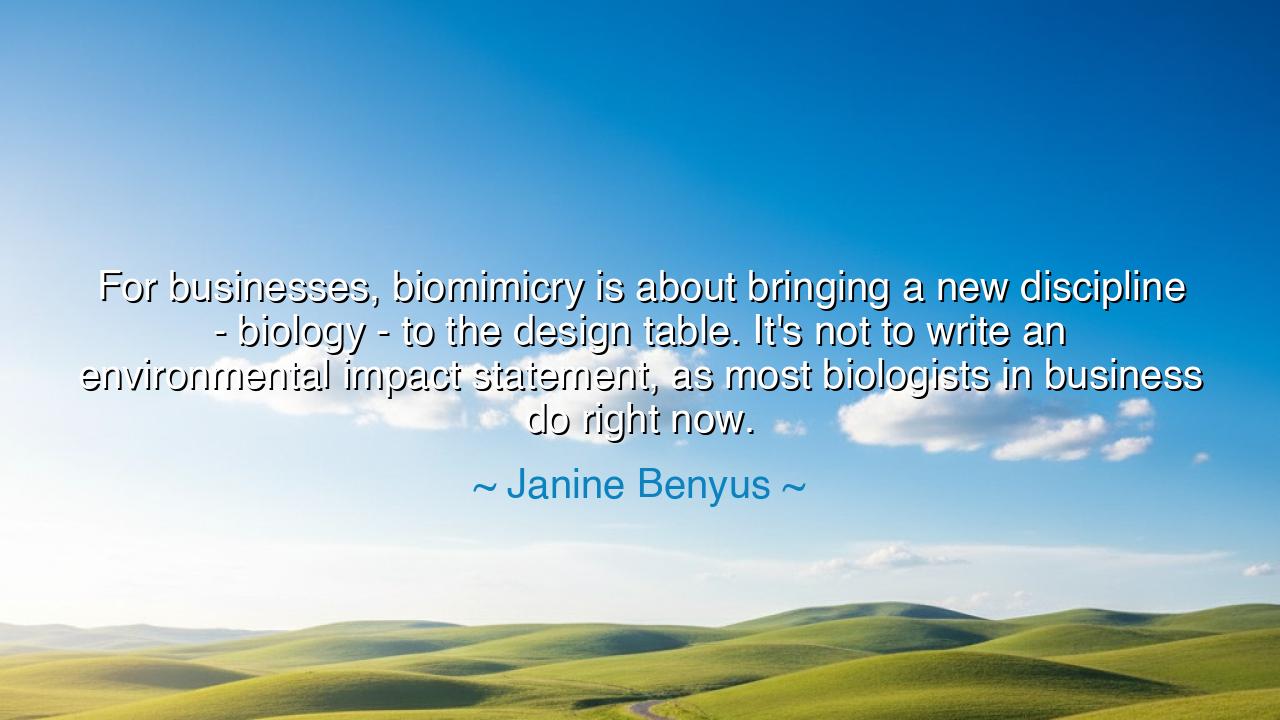
For businesses, biomimicry is about bringing a new discipline -
For businesses, biomimicry is about bringing a new discipline - biology - to the design table. It's not to write an environmental impact statement, as most biologists in business do right now.






In the words of Janine Benyus, the wise interpreter of nature’s genius, there shines a revelation both ancient and new: “For businesses, biomimicry is about bringing a new discipline — biology — to the design table. It’s not to write an environmental impact statement, as most biologists in business do right now.” These words are not merely about science or commerce — they are a call to reconnection. They remind us that humanity, though clever with machines and numbers, has strayed from the deep wisdom that first gave birth to its creativity: the wisdom of life itself. Benyus, who gave voice to the philosophy of biomimicry, calls for a return — a reunion of industry with the living world from which it was born.
The origin of this insight lies in Benyus’s lifelong study of nature’s quiet brilliance. To her, biomimicry is not just the imitation of natural forms — it is the emulation of natural principles, the deep patterns that allow ecosystems to thrive without waste or war. In her seminal work, Biomimicry: Innovation Inspired by Nature, she urged designers, engineers, and businesses to look beyond human arrogance and to seek mentorship in the designs of the Earth itself. For every problem we face — in energy, in architecture, in production — nature has already found an elegant, sustainable solution. The leaf makes fuel from sunlight. The spider spins silk stronger than steel. The forest manages abundance without greed. Benyus teaches that these are not curiosities to admire, but blueprints to follow.
When she says that biology must come to the design table, she means that nature should not be treated as an afterthought, consulted only when a project is done and an environmental impact statement must be written. By then, the damage has already been decided. Instead, she calls for biology as design partner, for nature to sit beside the architect and the engineer from the very beginning — not to restrict creation, but to enrich it. In her vision, the biologist is not a critic of industry, but its teacher. The question is not “How can we minimize harm?” but “How can we design in harmony with life?”
To understand the power of this shift, one need only look to the example of the Shinkansen bullet train in Japan. In its early years, the train’s speed created a sonic boom each time it exited a tunnel, disturbing communities and wildlife alike. The engineers turned, not to human precedent, but to nature’s engineers — and found inspiration in the kingfisher, a bird that dives from air to water without a splash. By modeling the train’s nose after the bird’s beak, they not only silenced the boom but made the train faster and more efficient. Here, biology became design — not an ornament to industry, but its guide.
Benyus’s words remind us that this is not mere innovation, but humility — the humility to admit that nature, refined by 3.8 billion years of evolution, is the greatest designer of all. In her vision, businesses must evolve from conquerors of the Earth to students of it. The old paradigm — of taking from nature and cleaning up afterward — is the way of exhaustion. The new paradigm — of learning from nature and designing with it — is the way of regeneration. It is a philosophy that heals the ancient wound between creation and conservation, between the marketplace and the meadow.
Her warning against treating biology as bureaucracy — as a mere environmental checklist — is profound. It is easy, in this age of sustainability slogans, for companies to use the language of green without embracing its spirit. But true biomimicry demands transformation, not decoration. It asks not, “How can we keep our profits while harming less?” but, “How can our profits nourish the planet that sustains us?” It is a hard question, for it demands imagination, patience, and reverence — qualities rare in the haste of modern commerce. Yet, Benyus reminds us, these are the very qualities that define life itself.
Therefore, my child of the modern world, take this teaching into your craft, whatever it may be. Whether you build, design, or dream, ask yourself: What would nature do here? Seek the wisdom of the forest, the sea, the stone, and the storm. Let the elegance of the spider’s web or the resilience of the coral reef be your mentors. In every design, let your first material be respect. For when biology returns to the table — not as ornament, but as oracle — creation becomes sacred once again.
For as Janine Benyus teaches, the future of design — and perhaps the survival of our species — depends not on how much we can dominate the world, but on how deeply we can learn from it. The answers we seek are already written in the feathers of birds, the patterns of shells, the songs of rivers. All we must do is listen. And when we do, we will find that our greatest technology was always before us: life, the first and most perfect designer.






AAdministratorAdministrator
Welcome, honored guests. Please leave a comment, we will respond soon